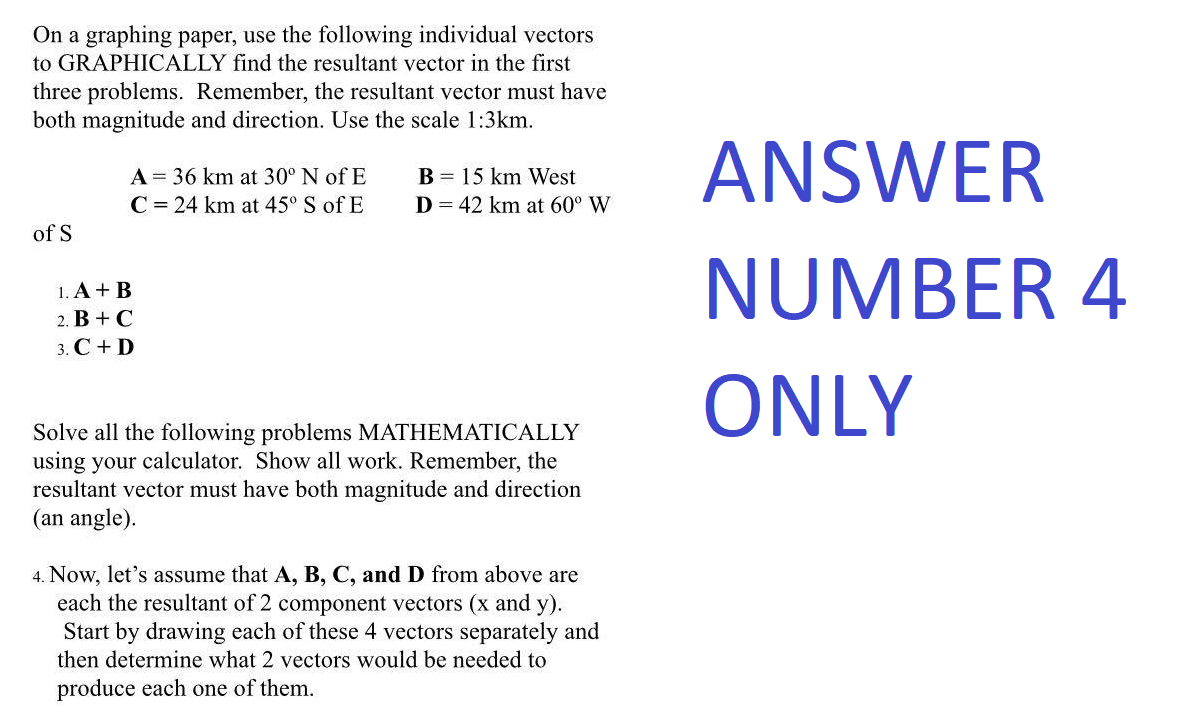4. Now, let's assume that A, B, C, and D from above are each the resultant of 2 component vectors (x and y). Start by drawing each of these 4 vectors separately and then determine what 2 vectors would be needed to produce each one of them.
4. Now, let's assume that A, B, C, and D from above are each the resultant of 2 component vectors (x and y). Start by drawing each of these 4 vectors separately and then determine what 2 vectors would be needed to produce each one of them.
Linear Algebra: A Modern Introduction
4th Edition
ISBN:9781285463247
Author:David Poole
Publisher:David Poole
Chapter1: Vectors
Section1.3: Lines And Planes
Problem 31EQ
Related questions
Question
100%
FOLLOW THE INSTRUCTIONS
DO THIS ONLY TYPEWRITTEN FOR UPVOTE
NO UPVOTE FOR TYPEWRITTEN
SKIP IF YOU ALREADY DID THIS OTHERWISE DOWNVOTE
THANK YOU

Transcribed Image Text:On a graphing paper, use the following individual vectors
to GRAPHICALLY find the resultant vector in the first
three problems. Remember, the resultant vector must have
both magnitude and direction. Use the scale 1:3km.
of S
A = 36 km at 30° N of E
C = 24 km at 45° S of E
1. A + B
2. B + C
3. C + D
B 15 km West
D = 42 km at 60° W
Solve all the following problems MATHEMATICALLY
using your calculator. Show all work. Remember, the
resultant vector must have both magnitude and direction
(an angle).
4. Now, let's assume that A, B, C, and D from above are
each the resultant of 2 component vectors (x and y).
Start by drawing each of these 4 vectors separately and
then determine what 2 vectors would be needed to
produce each one of them.
ANSWER
NUMBER 4
ONLY
Expert Solution
This question has been solved!
Explore an expertly crafted, step-by-step solution for a thorough understanding of key concepts.
This is a popular solution!
Trending now
This is a popular solution!
Step by step
Solved in 3 steps with 3 images

Recommended textbooks for you

Linear Algebra: A Modern Introduction
Algebra
ISBN:
9781285463247
Author:
David Poole
Publisher:
Cengage Learning

Trigonometry (MindTap Course List)
Trigonometry
ISBN:
9781305652224
Author:
Charles P. McKeague, Mark D. Turner
Publisher:
Cengage Learning

Linear Algebra: A Modern Introduction
Algebra
ISBN:
9781285463247
Author:
David Poole
Publisher:
Cengage Learning

Trigonometry (MindTap Course List)
Trigonometry
ISBN:
9781305652224
Author:
Charles P. McKeague, Mark D. Turner
Publisher:
Cengage Learning